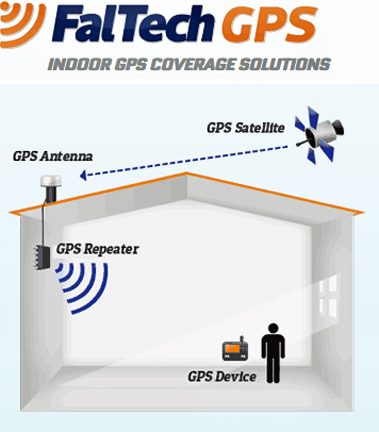
Iridium two-way satellite telephones are used all over the world; however, they generally can’t operate indoors, because the structure of the building blocks ingress and egress of the signal—this is where an Iridium repeater system comes into play, such as the launch by FalTech of their compact system at the Emergency Services Show (ESS) 2016 in Birmingham, England.
When it isn’t practical or safe to leave the building to use a satphone, a repeater system overcomes the building barrier and allows satellite communications at distance of up to 3 km from the outdoor antenna location. An outdoor unit (ODU) is installed on the roof, along with a pair of antennas—one for transmit and one for receive. The RF signal is converted to an optical signal by the ODU and transmitted along single-mode fibers up to 3Km inside (or even underground).
At the far end, an indoor unit (IDU) converts the optical signal back to RF and makes that signal available inside the building via a pair of ceiling-mounted antennas. GPS L1 and GLONASS signals are also passed through the repeater to the interior space. This means that satellite navigation devices will always receive a signal when indoors, eliminating any satellite acquisition delay when leaving the building.
An Iridium repeater with two outdoor and two indoor antennas and no optical fiber interfaces means it can be used when the distance from outdoor to indoor antennas is quite short, as compared to the optical version of the Iridium repeater that can extend the outdoor signal up to 3Km underground. Iridium repeaters are used in a wide range of situations, including underground civil defence/military bunkers, oil rigs/ships, large buildings and any other underground facility where satellite communications are required. However, it isn’t always necessary for the outdoor and indoor antennas to be a long distance apart. For example, when used in an aircraft hangar the ODU and IDU may be just a few meters apart.
The coaxial Iridium repeater was originally conceived to provide indoor coverage for the aviation MRO (maintenance, repair and overhaul) sector. However, the repeater lends itself perfectly to any other situation where the indoor and outdoor antennas can be fairly close together.

FalTech will be displaying a coaxial Iridium repeater system on stand R74 at the Emergency Services Show at The NEC on 21/22 September 21st and 22nd, 2016.
Phil Whitting, Managing Director of FalTech GPS, related that this is where the new coaxial repeater system is really useful, as it merges the ODU and IDU into one combined unit and removes the optical fiber interfaces. The single IP65 repeater unit is roof-mounted and comes with two indoor antennas and two outdoor antennas, with four 10 meter coaxial cables to connect it all together. This amounts to a “Lite” version that is smaller and cheaper than its optical fibre stablemates. Nonetheless, he added, it provides indoor coverage where such previously wasn’t available and is simple to install—and there's a three year warranty from the manufacturers.

